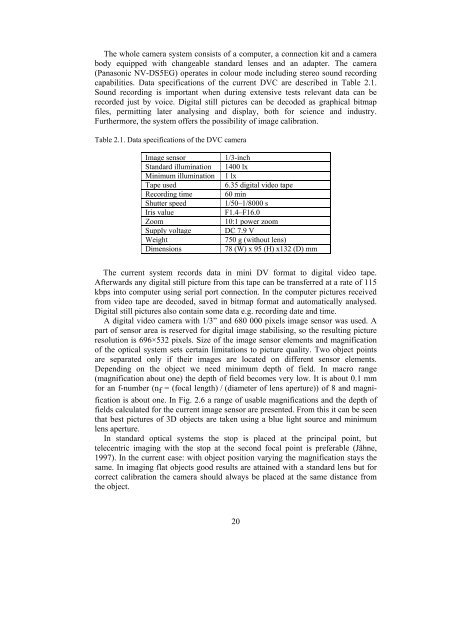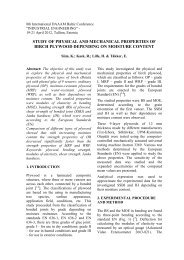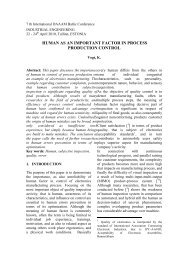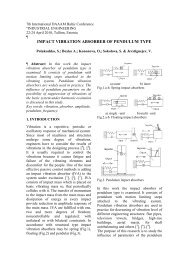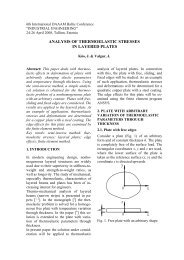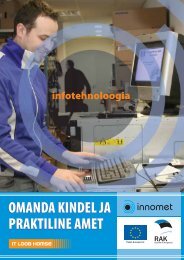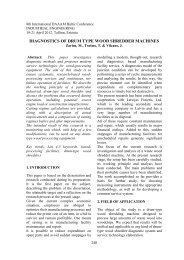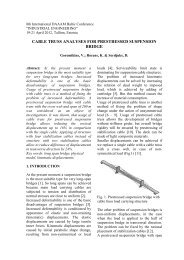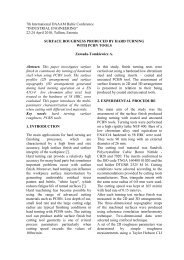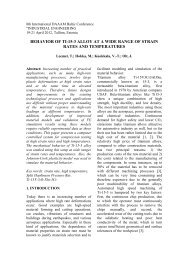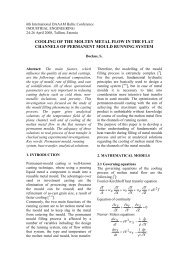Overview in PDF format - Tallinna Tehnikaülikool
Overview in PDF format - Tallinna Tehnikaülikool
Overview in PDF format - Tallinna Tehnikaülikool
You also want an ePaper? Increase the reach of your titles
YUMPU automatically turns print PDFs into web optimized ePapers that Google loves.
The whole camera system consists of a computer, a connection kit and a camerabody equipped with changeable standard lenses and an adapter. The camera(Panasonic NV-DS5EG) operates <strong>in</strong> colour mode <strong>in</strong>clud<strong>in</strong>g stereo sound record<strong>in</strong>gcapabilities. Data specifications of the current DVC are described <strong>in</strong> Table 2.1.Sound record<strong>in</strong>g is important when dur<strong>in</strong>g extensive tests relevant data can berecorded just by voice. Digital still pictures can be decoded as graphical bitmapfiles, permitt<strong>in</strong>g later analys<strong>in</strong>g and display, both for science and <strong>in</strong>dustry.Furthermore, the system offers the possibility of image calibration.Table 2.1. Data specifications of the DVC cameraImage sensorStandard illum<strong>in</strong>ationM<strong>in</strong>imum illum<strong>in</strong>ationTape usedRecord<strong>in</strong>g timeShutter speedIris valueZoomSupply voltageWeightDimensions1/3-<strong>in</strong>ch1400 lx1 lx6.35 digital video tape60 m<strong>in</strong>1/50–1/8000 sF1.4–F16.010:1 power zoomDC 7.9 V750 g (without lens)78 (W) x 95 (H) x132 (D) mmThe current system records data <strong>in</strong> m<strong>in</strong>i DV <strong>format</strong> to digital video tape.Afterwards any digital still picture from this tape can be transferred at a rate of 115kbps <strong>in</strong>to computer us<strong>in</strong>g serial port connection. In the computer pictures receivedfrom video tape are decoded, saved <strong>in</strong> bitmap <strong>format</strong> and automatically analysed.Digital still pictures also conta<strong>in</strong> some data e.g. record<strong>in</strong>g date and time.A digital video camera with 1/3” and 680 000 pixels image sensor was used. Apart of sensor area is reserved for digital image stabilis<strong>in</strong>g, so the result<strong>in</strong>g pictureresolution is 696×532 pixels. Size of the image sensor elements and magnificationof the optical system sets certa<strong>in</strong> limitations to picture quality. Two object po<strong>in</strong>tsare separated only if their images are located on different sensor elements.Depend<strong>in</strong>g on the object we need m<strong>in</strong>imum depth of field. In macro range(magnification about one) the depth of field becomes very low. It is about 0.1 mmfor an f-number (n f = (focal length) / (diameter of lens aperture)) of 8 and magnificationis about one. In Fig. 2.6 a range of usable magnifications and the depth offields calculated for the current image sensor are presented. From this it can be seenthat best pictures of 3D objects are taken us<strong>in</strong>g a blue light source and m<strong>in</strong>imumlens aperture.In standard optical systems the stop is placed at the pr<strong>in</strong>cipal po<strong>in</strong>t, buttelecentric imag<strong>in</strong>g with the stop at the second focal po<strong>in</strong>t is preferable (Jähne,1997). In the current case: with object position vary<strong>in</strong>g the magnification stays thesame. In imag<strong>in</strong>g flat objects good results are atta<strong>in</strong>ed with a standard lens but forcorrect calibration the camera should always be placed at the same distance fromthe object.20


